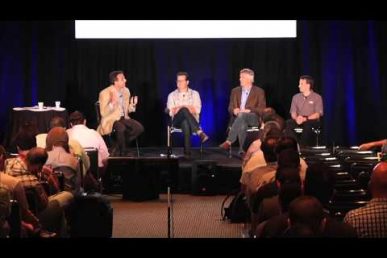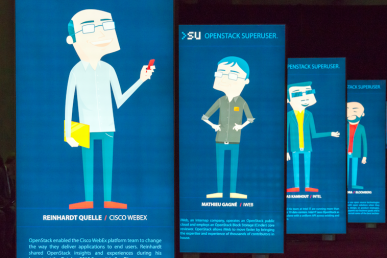We’re spotlighting users and operators who are on the front lines deploying OpenStack in their organizations to drive business success. These users are taking risks, contributing back to the community, and working to secure the success of their organization in today’s software-defined economy.
 Today, we sit down with Doug Soltesz the Vice President and CIO of Budd Van Lines, a national trucking company that moves over 6,000 families every year. Budd Van Lines is using OpenStack to backup its data and drastically reduce storage costs, giving the company the ability to invest in new initiatives that differentiate it from competitors.
Today, we sit down with Doug Soltesz the Vice President and CIO of Budd Van Lines, a national trucking company that moves over 6,000 families every year. Budd Van Lines is using OpenStack to backup its data and drastically reduce storage costs, giving the company the ability to invest in new initiatives that differentiate it from competitors.
Describe how are you using OpenStack. What kinds of applications or workloads are you currently running on OpenStack?
Budd Van Lines is a nationwide household goods carrier. In addition to moving over 6,000 families each year, we’re moving data. And a lot of it! We knew disaster recovery, cost efficiency and flexibility were crucial to our storage platform so we turned to OpenStack.
Through our nationwide fleet of trucks, we accumulate millions of documents, videos, and images throughout the year. All of these files are stored in OpenStack Swift from SwiftStack, our storage repository, and we offload backups and archival management. In addition, these platforms are helping us drive our paperless initiative.
In this storage domain, applications running on OpenStack have experienced a 10x reduction in storage costs. The OpenStack-run SwiftStack object storage platform is significantly less expensive than competitors. It’s also extremely hands-off; the system is very stable and extremely easy to manage. Importantly, very little of our IT department’s time has been spent on maintenance and updates. Basically, with the press of a button — boom, a backup is done! A lot of our other production systems have a similar button, yet the updates are not as seamless as the ones we’re implementing through OpenStack.
What business results, at a high level, have you seen from using OpenStack? What have been the biggest benefits to your organization as a result of using OpenStack? How are you measuring the impact?
Our tablet project is a great example of an OpenStack-enabled initiative. We try to iterate, test and launch our initiatives quickly before our busy season between Memorial Day and Labor Day. The ability for our software to evolve quickly is crucial. We must utilize the most current, efficient and impactful technology to beat our competition.
Going paperless is beneficial in so many ways. Not only are we able to be green and reduce paper usage, we’re ensuring that information is protected and saved. Depending on paper is risky; a coffee spill becomes detrimental instead of just a mess. Tablets allow our drivers to complete all the paperwork on the move. OpenStack allows for this information to be backed up across multiple sites, creating redundancy — vastly improving efficiency while reducing headache and heartache. Off the field, the home office is getting constant updates from drivers, communication is seamless and we can act quickly. We’re saving money, time and trees, and we owe this campaign’s success to OpenStack.
What is a challenge that you’ve faced within your organization regarding OpenStack, and how did you overcome it?
The main struggle is getting others to adopt OpenStack. New executives haven’t heard of OpenStack. As we are a quality-driven company, these folks are (rightfully!) wary of tech trends promising to be “cheaper and efficient” with no real proof points. The skeptics wanted to ensure that OpenStack wasn’t saving costs by cutting corners. Object storage is a relatively new storage type; our IT department was used to doing programming with SAN and NAS storage. Resistance for new adoption is found often in old school businesses; there’s a stigma that you’re taking a big risk. However, the transformative powers of OpenStack have converted the skeptics.
How has your team’s OpenStack deployment grown and developed? What were the resources at your disposal and scope of the project at the time, and what is it now?
We started our OpenStack venture with Swift; it’s been such a success that we want to expand to include other parts of the OpenStack puzzle. Swift’s reliability has opened the door to our test and development team to tinker with other OpenStack technologies.
When we began our OpenStack project, we were limited to virtual machines and retired servers/commodity hardware. What distinguished OpenStack was its ability to work with commodity hardware. You can load up versions of Swift and OpenStack with your older servers. There’s a versatility that doesn’t render old technology useless; it’s refreshing to get decent results without a massive overhaul.
Because of the experience and success we’ve had with OpenStack, Budd Van Lines is ordering specific hardware and newer equipment that will end up in production. We’re growing with OpenStack and it’s an exciting time.
If you run an OpenStack cloud and would like to be a contributor to Pass the Mic, email us with the subject line: Pass the Mic.
Also Read:
- Kilo Update: Swift
- Pass the Mic: Matt Haines, Time Warner Cable
- Pass the Mic: Ryan Burkhardt, GoDaddy
- OpenStack Superuser Reader for iOS
Photo Credit: Budd Van Lines
- Demystifying Confidential Containers with a Live Kata Containers Demo - July 13, 2023
- OpenInfra Summit Vancouver Recap: 50 things You Need to Know - June 16, 2023
- Congratulations to the 2023 Superuser Awards Winner: Bloomberg - June 13, 2023

)










